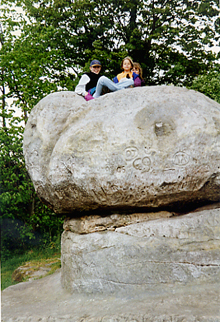|
|
|
|
|
|
|
A Short History Lesson
Salli
|
|
|
|

Samantha and Cassidy met up with this happy-go-lucky mastodon, a model of those who once walked this land.
|
|
|
|
We started the day in the rousing and vibrant Deptford Market, a collection of new and used goods accented by food stalls, spread out on the side streets and sidewalks of this southern London village. The place is filled with displaced Jamaicans, Africans, SE Asians, Chinese, Arabs, Indians, Pakistanis, Cockneys, Irish, Scots and English, the pattern of their language, clothing and music so much a part of London's cultural quilt. The market is the kind of place where you could buy back the stereo that was stolen last night, find fresh vegetables for tonight's dinner, stylish bargain clothes to go dancing in, and used everything.
|
|
|
|
After we purchased a few used sweaters, Chris took us exploring, working our way backward through English history as we left the boundary of London. Chris pointed out the different architectural styles as we sped through south greater London: Victorian, Edwardian, Georgian — how handy to have royalty to name things after! He pointed out that all the small towns we were careening through – Catford, Beckenham, Croyden, Bromley – were sleepy little villages until the rail line came through. They grew as the people who worked in the city moved out. And Americans thought they invented suburbia! You could tell who was ruling when the rail line arrived in each town by the predominant architecture of the area.
Before long we were in the verdant Kent countryside, hurtling along old Roman Roads, losing our way, consulting maps. The old roads are sunken, some by as much as eight feet. Chris said that a study showed that it took 100 years for one of these roads to sink an inch, and that the sinking stopped when the tarmac was put on. Like rings on a tree with a sudden tarmac-induced drought. The lanes wound around with hedges of boxwood and mayflowers, carpets of bluebells and high topped trees. Horses, sheep pigs and cattle grazed as they had for hundreds, perhaps thousands of years along the spokes of the roads leading to London.
Chris spoke of the landowners' responsibility to keep the hedges trimmed and the roadway clear. He said that British attitudes about property are shaped by the fact that, technically, a portion of all land title still rests with the Crown. Although people have "title" to the land,it is viewed by most as simply the right to use and take care of the land. It is for this reason that so many homes are named. The humans are just passing through, temporary caretakers. The home has a life of its own.
|
|
|
We visited the 15th century gray stone village of Chiddingstone, with its castle, ancient inn, church and graveyard, and of course, the Chidding Stone. The village in now part of the British Heritage, the Mother of All Caretakers for historic properties in Britain. As we left, we saw the coppery cone-shaped tops of former oast-houses. Once a working part of the brewing process, they are now a decorative part of country estates.
We finished the day visiting a megalithic stone circle built during the Neolithic age—about 5,000 years ago—on a private farm. The owner, Mrs. Bygraves, allows visitors to explore for a small fee. She looked like a favorite aunt or grandmother in her flowered frock and sensible shoes as she plodded along with us, talking about the culture and habits of the people who placed the stones. After she asked us why we thought the stones were placed here, her eyes twinkling as if she knew some enormous joke, she handed each of us a pair of divining rods.
As we walked slowly around the stones, she spoke about ley lines, troughs of magic earth-energy that crossed in the middle of the site. She smiled her approval as each of us stopped in surprise when the rods crossed. We did it again and again, and were amazed and exhilarated each time. It seems that we'd discovered the reason the stones were there. A powerful path guiding early British settlement as surely as the Roman roads or the rail roads of later times.
|
|
|
|
 Samantha and Cassidy survey the surrounding verdant countryside from atop the ancient standing rock of Chidding Stone for which the village of Chiddingstone is named. Samantha and Cassidy survey the surrounding verdant countryside from atop the ancient standing rock of Chidding Stone for which the village of Chiddingstone is named.
|
|
|
|
 The Slaughter-Mason girls soak their feet in the Slaughter Brook, retouching history. The Slaughter-Mason girls soak their feet in the Slaughter Brook, retouching history.
|
|
|
|
It was the beginning of the continuity that we found on this tiny island, of the bloodlines that we felt on some cellular level. As I visited the Cotswold / Gloucestershire villages of Upper and Lower Slaughter, which family legend describes as the wellspring or namesake, I feel at peace, centered, in a remarkable and surprising way. My own history is mixed with the winding River Eye (or Slaughter Brook) and flows over the honey-colored stone of the seventeenth century buildings and velvet-green fields. I am home. And I am pleasantly surprised.
A little aside - Although I grew up sure that my ancestors were killers because the name was Slaughter, I was told that the Slaughter villages were name from old or middle English/Saxon or Welsh "slohtre" or "sloghtre" meaning slow moving water, muddy place, slough or swamp. The family name first appeared in writing in Gloucestershire as "de Scloctres" in 1191, evolved to "de la Sloghtere" and "Slaghtere" around 1300, and finally "Slaughter" in 1572 (the names were William and Emma Slaughter - names that are frequent in my family tree).
|
|
|
|
|
|
|
|
|
|
|
|
|
|
|
|
|
|
|
|
|
|
|